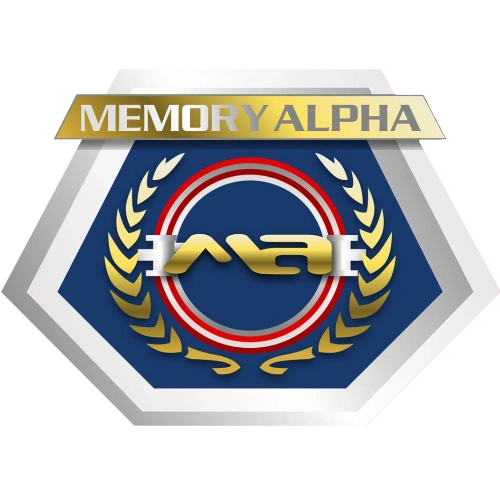| Klasa Galaxy | |
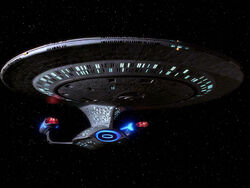
| |
| The Enterprise-D, a Galaxy-class starship | |
| Przynależność: | Federacja Gwiezdna Flota |
| Przeznaczenie: | Badawczy |
| W służbie: | 2360s- |
| Długość: | 642m |
| Pokłady: | 42 |
| Załoga: | około 1,014 (oficerowie, personel, i cywile) |
| Prędkość: | Warp 9.8 (Możliwa - duże ryzyko) Warp 9.6 (przez 12 godzin) Warp 9.2 (max. przelotowa) Warp 6 (początkowa średnia prędkość przelotowa) Warp 5 (późniejsze zalecenie Gwiezdnej Floty) |
| Uzbrojenie: | 12/14 baterie fazerów; 2 wyrzutnie torped; 250 torpeda fotonowa |
| Obrona: | Osłony |

| |
| Forward view | |
| Aft view | |
| Aft view | |
Klasa Galaxy była serią statków Gwiezdnej Floty po raz pierwszy wprowadzoną w późnych latach 50 XXIVw. Była to jedna z największych i najpotężniejszych serii statków Federacji w swoich czasie. Wiele z nich służyło w czasie wojny z Dominium.
Historia

Utopia Planitia design lab
Projektowanie i rozwój
Seria statków Galaxy zaczęto rozwijać w latach 50 XXIVw w Stoczni Floty Utopia Planitia. (TNG: „Booby Trap”, „Eye of the Beholder”) Wiele technologii zastosowanych w Klasie Galaxy było testowanych przez wcześniejsze statki prototypowe, m.in przez klasa Oberth USS Pegasus w latach 50 XXIVw. (TNG: „The Pegasus”)
Rdzeń Warp został zaprojektowany w Posterunku Seran-T-one w Dacie Gwiezdnej 40052 przez najwybitniejsze umysły Federacji,w tym dr Leah Brahms z Theoretical Propulsion Group. (TNG: „Booby Trap”)
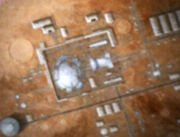
Galaxy class ship under construction at Utopia Planitia
Główne część konstrukcji statków klasy Galaxy wykonywano zarówno na orbicie jak i w obiektach znajdujących sie na powierzchni.
- Chociaż Star Trek: The Next Generation Technical Manual pokazuje długą, rozbudowaną historię konstrukcji klasy Galaxy, TNG: „Booby Trap” i Eye of the Beholder zdają się sugerować, iż zaprojektowano je i wprowadzono do służby raczej szybko, a ostatnie układy zostały zaprojektowane tylko rok przed startem the Enterprise-D. Sam statek był ciągle w trakcie budowy na rok przed TNG: „Encounter at Farpoint”.
W chwili oddania do służby , klasa Galaxy stała się najbardziej wyrafinowanym i złożonym technologicznie statkiem wybudowanym kiedykolwiek przez Federacje. (TNG: „Lonely Among Us”, „Contagion”)
Wczesne lata
Duże możliwości i wielkość statków klasy Galaxy uczyniły z nich wyjątkowo prestiżowe przydziały, przyciągające najlepszych i najzdolniejszych z Gwiezdnej Floty. (TNG: „Ménage à Troi”; VOY: „Relativity”) Stały się one znane z powodu swych możliwość wśród obywateli Federacji, jak i innych ras Kwadrantu Alpha . (TNG: „Tin Man”, „Chain of Command, Part I”; DS9: „Valiant”; VOY: „Infinite Regress”) Klasa Galaxy była wyjątkową wśród statków Gwiezdnej Floty z powodu obecności dużej liczby cywili na pokładzie.
W 2365, bezpieczeństwo klasy Galaxy, w szczególności napędu warp, stanęło pod znakiem zapytania, gdy USS Yamato został stracony w zagadkowym wypadku niedaleko Romulańskiej Strefy Zdemilitaryzowanej. Statek doświadczył rozległych, ogólno systemowych usterek, które w końcu doprowadziły do utraty pola utrzymującego antymateria. Dalsze śledztwo prowadzone przez Enterprise-D ujawniło, iż za awarię odpowiedzialny był transfer oprogramowania od Ikonian, a nie wady konstrukcyjne statku. (TNG: „Contagion”)
Niewątpliwie najbardziej uznanym we wczesnych latach statkiem klasy Galaxy był USS Enterprise-D, który poza dwoma krótkimi okresami pod dowództwem Williama T. Rikera i Edwarda Jellico, był dowodzony przez całą 9 letnią służbę przez Kapitana Jean-Luca Picarda. Enterprise ustanowił Pierwszy kontakt z wieloma nowymi gatunkami, włącznie z Kontinuum Q, Ferengi i Kolektywem Borg. Jego wysiłki dyplomatyczne pomogły ostudzić napięcie między mniejszymi, lokalnymi potęgami i zapobiec wielkiemu zagrożeniu dla bezpieczeństwa Federacji w czasie Klingońskiej wojny Domowej, oraz okazjonalnie sprawdzać operacje Romulan i Kardasian w napiętych sytuacjach. Enterprise-D brał udział w najcięższych walkach Federacji, m.in. zapobiegając asymilacji Ziemi w trakcie inwazji Borga w 2367. (Star Trek: The Next Generation)
Wojna z Dominium
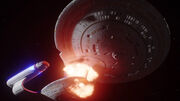
The USS Odyssey critically damaged
Statek klasy Galaxy brał udział w katastrofalnym w skutkach pierwszym kontakcie z Dominium. USS Odyssey wkoroczył do Kwadrantu Gamma w celu uratowania grupki obywateli Federacji, którzy zostali wzięci do niewoli przez Jem'Hadar. Gdy USS Odysey wycofywał się, szturmowiec Jem'Hadar uderzył w samobójvczym ataku w część napędową statku, tworząc ogromne pęknięcie poszycia powodujące całkowite zniszczenie statku. (DS9: „The Jem'Hadar”) Ten nie uzasadniony akt doprowadził do 3 letniego okresu wrogości miedzy Federacją a Dominium, który zakończył sie rozpoczęciem Wojny z Dominium.
Statki klasy galaxy brały udział w wielu większych działaniach floty w czasie wojny, włączając w to: Operacje Powrót, gdzie statki te również odegrały ważną strategicznie role, (DS9: „Sacrifice of Angels”) pierwsza Bitwę o Chin'toka, (DS9: „Tears of the Prophets”) i Bitwę o Kardasję. (DS9: „What You Leave Behind”)
- Analiza efektów specjalnych z DS9: „Sacrifice of Angels”ukazuje nie mniej jak pięć, być może nawet dziewięć statków klasy Galaxy w łączonej flocie Federacji w Operacji Powrót. Podczas gdy intencją firmy SFX było zapełnienie przestrzeni większą ilością statków (flota liczyła w przybliżeniu około 600 statków), to wskazywało by to na to, iż jest więcej niż początkowe sześć statków klasy Galaxy wymienionych w TNG Technical Manual. 'Technical Manual także mówi o tym, iż Gwiezdna Flota zachowała części pozwalające na wybudowanie kolejnych sześciu statków klasy Galaxy. Części te mogły by zostać wykorzystane do wzmocnienia floty na czas wojny, albo do uzupełnienia starz z Wolf 359. Przy całkowitej ilości wyprodukowanych statków klasy Galaxy w liczbie dwunastu, i wiedzy o starcie: USS Enterprise-D, USS Yamato, iUSS Odyssey,możemy obliczyć, iż we flocie znajdowało się dziewięć statków klasy Galaxy. Jeśli jednak statki widziane w trakcie bitwy nie reprezentują całej floty statków Galaxy, to jest możliwe, iż było ich wiecej jak sześć albo dziewięć.
The USS Galaxy at the First Battle of Chin'toka
Lata późniejsze
Kilka statków klasy Galaxy weszło w sklad floty w latach 70tych XXIVw . (VOY: „Relativity”) W drugiej połowie dekady statki te były widziane na całej Przestrzeni Federacji, od Ziemi (VOY: „Endgame”), aż do Romulańskiej Strefy Zdemilitaryzowanej. (Star Trek: Nemesis)
W Alternatywnej lini czasowej, statki klasy Galaxy pozostawały w służbie dłogo po roku 2370, chociaż uczyniono pewne próby w celu usunięcia ich ze służby. (TNG: „All Good Things...”)
- Przynajmniej trzy, może cztery statki klasy Galaxy były widziane w trakcie konstrukcji w Stoczni Floty Utopia Planitia w VOY: „Relativity”. Przynajmniej pięć, może siedem statków tej klasy brało udział w próbie przechwycenia przez flote kuli Borg w VOY: „Endgame”.
Dane techniczne
Wykończenie wnętrz
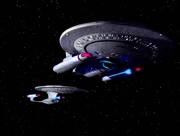
Nebula- and klasa Galaxy starships.
Statki klasy Galaxy w swym projekcie są bardzo zbliżone do swego mniejszego odpowiednika jakim klasa Nebula.
- Niewiadomo czy projekt jedne klasy wywodzi sie z drugie, czy tez zostały one zaprojektowane jednocześnie. Jedynym chronologicznym dowodem może być tabliczka dedykacyjna,która ujawnia fakt iż statek klasy Nebula-USS Phoenixzostał wprowadzony do służby (w Dacie Gwiezdnej 40250.5) na krótko przed startem (data Gwiezdna 40759.5) statku klasy Galaxy- USS Enterprise-D
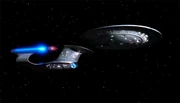
Saucer separation in progress
The Galaxy-class had two hull sections, a saucer-shaped primary hull and a secondary hull on which were mounted the two warp nacelles. The hulls were capable of reversible saucer separation and were both equipped with independent flight and combat capabilities. Generally, civilians and non-essential personnel would evacuate to the saucer module, while the senior staff confronted a threat in the battle section, which contained the majority of weapons systems. (TNG: „Encounter at Farpoint”) The saucer was even capable of crash-landing on a planetary surface. (Star Trek Pokolenia)
- Although children appeared to be evacuated from the star drive section in Generations, Ronald D. Moore commented: "I believe the children were actually being rushed to their "crash stations" or "emergency stations" or something, not being brought up from the battle section. The same goes for the patients in sickbay." [1]
The hull of the Galaxy-class was left somewhat customizable; areas such as Deck 8 were designated as unfinished and multi-purpose, in the event that extra space was needed for a specific mission. (TNG: „Liaisons”)
- According to the Star Trek: The Next Generation Technical Manual, when the Enterprise-D was initially launched from Utopia Planitia, a full 35% of the the customizable space was left empty, to be later filled with individual modules as seen fit.
Układy Dowodzenia i Kontroli
The computer system on board the Galaxy-class was isolinear based. (TNG: „The Naked Now”) Computer systems were concentrated in a computer core, which was accessible through a maintenance room. (TNG: „Evolution”) Each Galaxy-class vessel carried a total of three independent computer cores; two located in the saucer section and one in the engineering section.
- According to the non-canon but Memory Alpha permitted resource Star Trek: The Next Generation Technical Manual, all of the ship's essential computer processing functions may be handled by a single core.
Napęd
Impulse engine (aft torpedo launcher is also visible)
Galaxy-class ships achieved warp flight through two warp nacelles, which housed multiple pairs of warp coils. (TNG: „Eye of the Beholder”) The acceleration delay between slow-reverse impulse and top warp speed, or about warp 9, was 0.300 milliseconds. (TNG: „The Last Outpost”) The maximum speed was warp 9.6, which could be maintained for approximately twelve hours. (TNG: „Encounter at Farpoint”, „The Best of Both Worlds”) The warp core was one of the most powerful in Starfleet, generating approximately 12.75 billion gigawatts (12.75EW (exawatts) / 1.275x1019W / 12,750,000,000,000,000,000W) (12.75 quintillion watts) of power. (TNG: „True Q”) The efficiency of the warp drive could be tweaked to a point where it rivaled the new klasa Intrepid ships introduced in 2370. (TNG: „Force of Nature”)
The warp core spanned twelve decks in the engineering hull. The deuterium tanks were above the core, while antimatter storage pods surrounded the base of the core on Deck 42. (TNG: „Liaisons”)
There were three impulse engines, two on the saucer section and one in the stardrive section. In early ships, only the impulse engine in the stardrive section was usually active.
Ulepszenia

The navigational deflector dish of a Galaxy-class starship
Upgrades to the propulsion systems were tested in 2370 aboard the Enterprise-D; the ship received a new warp core manufactured with interphase technology. (TNG: „Phantasms”) A major overhaul of the nacelles was also conducted that year. (TNG: „Eye of the Beholder”) By the mid 2370s, most Galaxy-class ships began operating with all three impulse engines activated. (DS9: „Favor the Bold”; VOY: „Timeless”)
Układy naukowe
Galaxy-class ships supported a wide variety of scientific equipment and laboratories studying many different disciplines. (TNG: „Liaisons”) The departments often had to compete for limited resources such as sensor time, which were allocated by the operations officer or, on occasion, the executive officer. (TNG: „Lessons”)
Ulepszenia
Sensor systems could be customized and upgraded as necessary for a specific mission. Additional equipment could be added as required. (TNG: „Cause and Effect”, „Schisms”) The latest technologies were generally outfitted to Galaxy-class ships as they left the experimental stages. (TNG: „All Good Things...”)
Układy Taktyczne
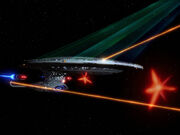
A Galaxy-class starship fires its phasers and photon torpedoes
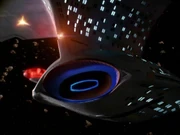
A Galaxy-class starship's forward torpedo launcher
The Galaxy-class was equipped with ten phaser banks, located at various points along both hulls. One array was located on the dorsal of the battle section and could only be used following a separation. There were also fore and aft torpedo launchers on the engineering section. (TNG: „Conundrum”) Each launch tube was capable of firing at least five photon torpedoes simultaneously, each torpedo capable of being independently targeted. (TNG: „The Arsenal of Freedom”, „Yesterday's Enterprise”) In the 2360s, Galaxy-class ships typically carried about 250 photon torpedoes. The torpedo launchers were also capable of launching probes. The Galaxy-class also supported a high-capacity deflector shield grid, with a weakness where the impulse exhaust destabilised the shields. (TNG: „Conundrum”)
- While "Conundrum" establishes that there were only ten phaser banks aboard the ship, a visual inspection shows twelve arrays and effects have established extra emitters on the nacelle pylons and in the forward torpedo launcher (TNG: „The Best of Both Worlds”, „Darmok”) The aft firing saucer launcher was never established in dialogue, but is visible on the filming model. Star Trek: The Next Generation Technical Manual states 10 torpedoes can be launched simultaneously and 275 torpedoes are usually carried by the ship.
Ulepszenia
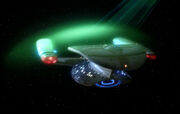
The deflector shields of a Galaxy-class starship's secondary hull
The Enterprise-D received weapons systems upgrades in 2370, including a loadout of higher-yield photon torpedoes and enhanced targeting sensors programmed by Lieutenant Worf. (TNG: „Genesis”) Certain Galaxy-class ships, such as the USS Venture, were refitted with additional phaser strips on the dorsal surfaces of their nacelles by 2372. (DS9: „The Way of the Warrior”)
- This modification is an artifact left over from the changes made to the four-foot Enterprise model for TNG: „All Good Things...”, although the "bumps" containing the phaser arrays on the Venture seem to have been rotated a full one-hundred eighty degrees from those on the Enterprise-D. The Venture was the only ship to have these modifications; none of the CGI Galaxy-class ships used exclusively since the fifth season of DS9 (including the Venture itself) are modified in such a manner.
Wsparcie dla załogi
While Starfleet policy permitted the immediate family of officers and crew to stay aboard starships prior to the advent of the Galaxy-class, it was the first class specifically tailored to accommodate civilian as well as Starfleet personnel. (TNG: „Encounter at Farpoint”) Civilians were allowed to hold varying positions in the science division aboard the Galaxy-class. (TNG: „Night Terrors”)
- Regarding the presence of families on starships, Ronald D. Moore commented "Perhaps [still] on some Galaxy-class ships, but I think this was an experiment that failed." [2] "I think that the "family friendly" starship notion was an interesting idea, but one that didn't pan out. There was always something awkward about Picard ordering the ship into battle situations with kiddies running through the corridors. And no matter how much lip service we paid to the "our families are part of our strength" concept, it never seemed very smart or very logical to bring the spouse and kids along when you're facing down the Borg, or guarding the Neutral Zone, or plunging the ship into uncharted spatial anomalies." [3]
Wygląd wewnętrzny
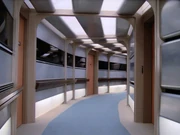
A typical saucer section corridor
With the presence of families and non-Starfleet personnel aboard, the Galaxy-class interior was mostly designed for their comfort and the well being of the crew in general. While the major command sections maintained form and functionality above all, there remained a much more "relaxed" feel about the design of many of these areas.
- In Star Trek Pokolenia, the interior lighting scheme of the Enterprise-D was noticeably darkened.
Mostek Główny
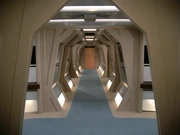
A corridor in the engineering section
The main bridge, fore starboard view
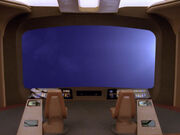
The ops and conn consoles
The main bridge of the Galaxy-class was located on Deck 1 of the saucer section. As with most starships, the main bridge was modular and could be completely replaced with another bridge if the need called for it. Different Galaxy-class starships had different bridge designs. The following describes the bridge design used in at least two Galaxy-class starships, including the USS Enterprise-D.
- The theory of different bridge designs for different Galaxy-class starships comes from DS9: „The Jem'Hadar”, where the USS Odyssey featured a completely different bridge design from that of the USS Enterprise-D, though this can be explained by the fact that Star Trek Pokolenia was being filmed at the same time as DS9: „The Jem'Hadar” and as such, the Enterprise-D set was unavailable.
The forward bulkhead was dominated by the main viewscreen. Directly aft of this were the operations officer and conn positions. At the very center of the room was the command area – the captain's chair at the center, flanked by chairs for the first officer to the right, and an additional officer (typically the ship's counselor or chief medical officer) to the left. Smaller backless seats were located on the edges of the command area, for other officers to sit, should the need arise.
- In the pilot, as well as early in the first season, the forward bridge consoles don't seem to be dedicated specifically to either helm control or operations since Data, the operations officer, can be seen in both the left and right stations at different times. The console seats were also more reclined in earlier seasons, but became more upright in later seasons.
The tactical console, positioned directly behind the captain, was located in the wooden handrail that encircled the rear half of the central command area. The aft bulkhead carried several additional consoles. These could be customized as needed (TNG: „Chain of Command, Part I”) and were reconfigured at least twice. In 2364, the consoles, from starboard to port, were Science I, Science II, Environment, Emergency Manual Override, and Propulsion Systems. By 2365, they were Science I, Science II, Mission Ops, Environment, and Engineering. The stations featured pullout seats below the console, which were normally flush with the panel below the stations. The bridge was also equipped with two food replicators.
- It's conceivable that any console on the bridge can be converted to any role. An example of this can be seen in the game Star Trek: Bridge Commander, where the "tactical" console was reconfigured for engineering and sciences.
By necessity, the bridge had easy access to and from all other important areas of the ship. In all, there were six doors leading from the room. Moving clockwise from the main viewscreen, the first door, level with, and to the right of the conn, lead directly to the battle bridge emergency turbolift. At the rear right of the bridge, a shallow alcove contained two doors, one of which led to a head, the other to a corridor leading to the observation lounge. The door at the rear left of the room opened onto a standard turbolift. Continuing around, the fifth door lead into the captain's ready room, the sixth to another turbolift. (TNG: „Encounter at Farpoint”)
As the main bridge housed so many critical systems, numerous emergency environmental and power backups were included so that duty personnel could continue to work for up to 72 hours in the event of a major shutdown or incapacitation of the vessel. Other safeguards included seven redundant safety interlocks to prevent the life support from being turned off on the bridge. (TNG: „Brothers”)
Ulepszenia
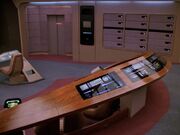
The security station, integrated in the wooden handrail
The bridges of Galaxy-class ships were subject to several minor cosmetic changes over their first decade of service. The first major refit came in 2371 as seen aboard the USS Enterprise-D. Six new stations were added, three on each side of the bridge replacing the equipment lockers. The aft stations were accordingly reprogrammed and moved to different locations. The three starboard stations were designated Science I, II, and III. Science IV became the first aft station, followed by Mission Ops, Environment, and Engineering I/II. The port side of the bridge had three communications stations, consoles which were not common to the bridges of 24th century ships. In addition, the command chairs were raised two steps above the helm and ops stations, to provide the captain with an unobstructed view of the forward viewscreen. New carpeting and handrails were also added. (Star Trek Pokolenia)
Sala Obserwacyjna
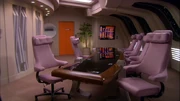
The observation lounge
The observation lounge was located directly aft of the main bridge. The room was usually used as a conference room for the vessel's senior staff. It featured large, aft-facing windows that offered a spectacular view of the back of the starship and space beyond. A conference table with seating for ten people was the main feature of the room, (TNG: „Encounter at Farpoint”) with LCARS screens on the port and starboard walls for information displays and retrieval. (TNG: „The Child”) Holographic emitters embedded within the table could also be used for presenting data. (TNG: „The Last Outpost”) Some starships featured artwork along the wall opposite the windows; when this was not present the bare wall showed several structural supports. (TNG: „Darmok”)
Mostek Bojowy
The battle bridge
The battle bridge was located on Deck 8 and was connected to the main bridge and other vital areas of the ship by an emergency turbolift. It was designed to control the stardrive section following a saucer separation. Unlike the main bridge, there was much more focus on combat and tactical systems and no science stations. The battle bridge was modular, like the main bridge; at least two variants have been seen aboard Galaxy-class ships. (TNG: „Encounter at Farpoint”, „The Best of Both Worlds, Part II”)
- The battle bridge was stated as being on Deck 17 according to TNG: „Heart of Glory”.
Główna Maszynownia
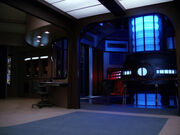
Main engineering
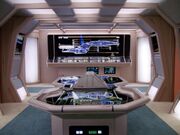
The "pool table" and the MSD
Engineering systems spanned twelve decks of the engineering section. Engineering itself was located on Deck 36 (TNG: „Liaisons”) and was an open-plan facility, directly accessible from the corridor. Consisting of two levels, it provided direct access to the vessel's warp core and primary engineering support systems. The corridor bulkhead housed the Master Situation Monitor. Inside the main section, the master systems display, affectionately known as the pool table, was the operational focus of the room. Beyond this, heading towards the warp core, the chief engineer's office and several support consoles were located on the left, and the assistant chief engineer's console on the right. These formed part of the bulkhead protecting the main part of Engineering from the warp core. Access to the upper level, a circular area surrounding the warp core, was provided by a ladder to the left of the warp core or an elevator on the right. The upper level had access to other warp core maintenance systems. (TNG: „The Dauphin”, „The Best of Both Worlds, Part II”)
Engineering could also serve as a backup to the main bridge if it was damaged or disabled. (TNG: „Brothers”)
In the event of a major failure, such as an imminent warp core breach, engineering was equipped with isolation doors and forcefields to contain various sections of the facility, usually to seal off the warp core prior to detonation or ejection. (TNG: „The Best of Both Worlds”, „Violations”; Star Trek Pokolenia)
Udogodnienia Medyczne
The Galaxy-class medical department was charged with providing health care to the ship's company and all attached personnel.
Ambulatorium
Intensive care unit
There were at least three sickbay wards aboard the ship, (TNG: „Tapestry”) with at least one in the saucer section (TNG: „Genesis”) and another in the stardrive section. (TNG: „The Arsenal of Freedom”) There were four recovery biobeds on the periphery of the room with a main surgical biobed opposite them, covered by a large overhead sensor cluster and capable of hookup to a surgical support frame. Equipment storage and various control panels were located throughout sickbay. The chief medical officer's office was a small space just off the main sickbay, with desk and workspace for the CMO. A small foyer connected the office to the sickbay; it contained a replicator terminal.
Separate, private recovery rooms were also located near sickbay (TNG: „Ethics”) as was a nursery (TNG: „Home Soil”, „Data's Day”) and a diagnostic center. (TNG: „Transfigurations”)
A Galaxy-class sickbay also had the facilities to isolate parasitic protoviruses. (TNG: „Brothers”)
Laboratoria Medyczne
The CMO's office
Galaxy-class ships had at least four medical laboratories of varying sizes. There was a small laboratory accessible through the foyer outside the chief medical officer's office where minor experiments run by on-duty personnel could be monitored. (TNG: „Home Soil”, „Evolution”, „Clues”) Other larger medlabs similar to standard science labs were elsewhere. (TNG: „Ethics”)
Sala Operacyjna
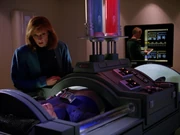
The emergency bio support unit
Surgeries too complicated for the sickbay ward could be conducted in a separate surgical area which had a large variety of bio-support systems. (TNG: „Ethics”)
Awaryjna jednostka podtrzymująca życie
There was a separate room located near the main sickbay facility on Deck 12 that contained the emergency bio-support unit. Patients with severe burn injuries could be treated here in a closed cell. (TNG: „Transfigurations”)
Kostnica
A morgue facility with storage slots for several bodies was located adjacent to sickbay. (TNG: „Man of the People”, „Suspicions”)
Biuro Doradcy
The ship's counselor had his or her own office, located on Deck 9. Crew members needing emotional support could meet in private with the counselor here. (TNG: „The Price”)
Wydział Naukowy
The Galaxy-class starship housed over one hundred separate scientific research labs. Very few of the research labs remained under the same discipline of science for more than six months. Most shared the same design; only a few had extremely specialized equipment.
Kartografia Gwiezdna
The vessel also housed a stellar cartography department, located on Deck 9. There were at least two laboratories based there; one, a smaller facility similar to the other labs aboard the ship; another, a much larger cylindrical room spanning three decks. The walls of the room were designed to be a three-dimensional display. (Star Trek Pokolenia)
Laboratorium Cybernetyczne
Cybernetics lab
Aboard the Enterprise-D, the cybernetics lab was a circular room, with a raised platform in its center containing a shell which could hold a cybernetic body. The entire assembly could retract into the ceiling and was directly controlled by a console to the side. There were additional wall-mounted consoles throughout the room. (TNG: „The Offspring”) The laboratory was redesigned in 2368 and altered to become much more rectangular, although it still featured the shell assembly. (TNG: „I Borg”, „The Best of Both Worlds, Part II”)
Arboretum
The arboretum was capable of studying and supporting a wide variety of plant life, and also doubled as a social area. (TNG: „Night Terrors”, „Imaginary Friend”, „Dark Page”)
Laboratoria Waleni
The Galaxy-class starship carried a complement of cetaceans. Among the crew, these facilities were also known as "the dolphin tanks" (TNG: „The Perfect Mate”) or the "aquatic lab." (TNG: „Genesis”) In an alternate timeline, these facilities were also known as Cetacean Ops. (TNG: „Yesterday's Enterprise”)
- These labs are shown in the saucer section in the Star Trek: The Next Generation USS Enterprise NCC-1701-D Blueprints and are mentioned in the TNG Technical Manual. While the area itself was unfortunately never seen on the show, their existence has been confirmed in dialog.
Transport i Ładunek
Sala Transportera
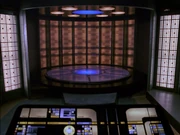
Transporter room
Galaxy-class starships had twenty transporter rooms located throughout the vessel. (TNG: „11001001”) Four transporter rooms were located on Deck 6 in the saucer section, (TNG: „The Game”) while two more were on Deck 14 in the stardrive section. (TNG: „Encounter at Farpoint”)
Hangar
Main Shuttlebay, external view
There were three shuttlebays aboard each Galaxy-class starship, supporting many varieties of shuttlecraft. The main shuttlebay was located on Deck 4 in the saucer section. It was so massive that an explosive decompression of the air within the bay would contain enough force to propel the ship forward. (TNG: „Cause and Effect”) Two smaller shuttlebays were on Deck 13 in the engineering hull. (TNG: „The Next Phase”)
- The main shuttlebay would have been prohibitively expensive to build as an actual set, and was only seen in miniature form during TNG: „Cause and Effect”. During the first few seasons of Star Trek: The Next Generation, Shuttlebays 2 and 3 were erroneously shown on Deck 11.
Zaokrętowane statki
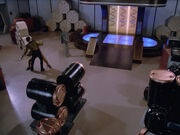
A typical cargobay
- type-6 shuttlecraft (TNG: „Darmok”)
- type-7 shuttlecraft (TNG: „Coming of Age”)
- type 15 shuttlepod (TNG: „Time Squared”)
- klasa Danube runabout (DS9: „Emissary”)
- captain's yacht
Ładownia
There were numerous multi-level cargo bays located all throughout the ship. Most of these bays contained sufficient room for storage, cargo transporters, and anti-grav units for the transportation of cargo. (TNG: „The Hunted”, „Hollow Pursuits”) Cargo bay four was the only cargo bay with direct access to the exterior hull. (TNG: „Power Play”)
Kwatery Załogi
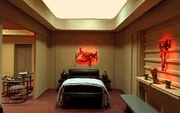
Junior officers' quarters
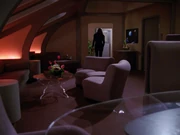
Standard officers' quarters
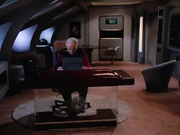
Luxurious VIP quarters
Most crew quarters on the Galaxy-class were located in the ship's saucer section, in order to provide safety for civilian and non-essential personnel during a saucer separation. However, the engineering hull also contained crew quarters, generally containing engineering personnel and their families. (TNG: „Imaginary Friend”; Star Trek Pokolenia) Pets, including cats and dogs, were also allowed aboard ship. (TNG: „Data's Day”)
There were several types of crew quarters aboard:
- Junior officers' quarters - These small-unit quarters were located on the interior of the ship and lacked windows. They were comprised of a living area, a bedroom, and a bathroom. Crewmembers of Lieutenant Junior Grade were given their own quarters; ensigns were required to share quarters. (TNG: „Lower Decks”) The living area contained a replicator terminal and was customizable with a variety of furniture and decorations.
- Officers' quarters - These quarters lined the edge of the saucer section and contained a living area, a bedroom, and a bathroom area. (TNG: „Schisms”, „Frame of Mind”, „Genesis”) They were generally reserved for lieutenant commanders and above. Similar quarters were also available to enlisted and civilian personnel with families. (TNG: „The Wounded”)
- Captain's quarters - The captain's quarters, located on Deck 8, were similar to the officers' quarters but were slightly larger. The captain had a large desk area and work terminal. VIP and diplomatic guest quarters shared the same layout. (TNG: „Too Short a Season”, „Sarek”)
Rozrywka na pokładzie
Dziesiąty Dziobowy
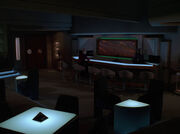
The Ten Forward lounge
Located at the forward-most section of the saucer module on Deck 10(deck 10, forward station one), Ten Forward served as the social center of the ship. It had a battery of recreational games including three-dimensional chess as well as a fully stocked bar which carried syntheholic beverages. The replicators were also able to produce other food and drinks for the crew to enjoy in a relaxed social setting. Its large, panoramic windows permitted a staggering view of the ship's passage through space. (TNG: „The Child”, „Power Play”)
- To date, Ten Forward has only been shown on board the USS Enterprise-D. However, there is no evidence proving that it was not a feature of every Galaxy-class ship. Given the extended duration of their missions, it is likely that designers included this feature on her sister ships to serve their recreational and social needs as well. In the novel The Return, Ten Forward is replaced by "Shuttlebay Four".
Holodeck
The Galaxy-class carried sixteen holodecks, which are located on Decks 9, 10 and 11. (TNG: „11001001”, „Homeward”)
Kort do racquetballa
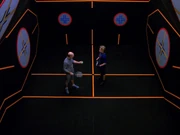
The racquetball court
The phaser range was located on Deck 12. A person stood on a platform in the center of the room, illuminated only by the light which came from above the platform. Colored circular lights, approximately the size of a Human hand, whirled across the walls, and the person aimed and fired at selected targets. After completing a round, the number of hits and misses, along with the percentage of accuracy, were tallied by the ship's computer. There were at least fifteen levels of difficulty, and the range could be customized for two-player competition.
The phaser range was also used by security officers to train personnel in marksmanship. (TNG: „A Matter Of Honor”, „Redemption II”)
Sala Gimnastyczna
The fencing room
The gymnasium, which was also on Deck 12, contained a variety of recreational equipment for a variety of sports. In addition to aerobic studios (TNG: „The Price”) and martial arts areas (TNG: „Clues”, „Second Chances”), there was a parrises squares area (TNG: „Second Chances”), a squash court, (TNG: „Suddenly Human”) and an anbo-jytsu court. (TNG: „The Icarus Factor”) The gymnasium also featured a fencing room. Aboard the Enterprise-D, Captain Picard usually fenced with fellow crewmembers. (TNG: „We'll Always Have Paris”, „I Borg”)
Teatr i Sala Koncertowa
The theater and concert hall
There was a large theater aboard, which was equipped to seat large groups of people. The theater could also be used as a concert hall for musical performances by crew members. (TNG: „Sarek”, „Frame of Mind”)
- The theater set was a reuse of the Ten Forward set.
Salon
The salon was an area where crewmembers could get personal care ranging from a simple haircut to an elaborate spa-like treatment. (TNG: „Data's Day”, „The Host”, „Schisms”)
Replimat
At the replimat, crewmembers could replicate items which were too large or complicated for a standard food replicator terminal. They could "shop" for certain items by reviewing the fabrication database. (TNG: „Data's Day”)
Edukacja
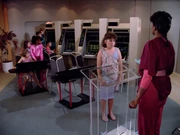
A small school
There were several small schools of varying sizes located throughout the ship, ranging from actual classrooms (TNG: „When The Bough Breaks”) to specialized workshops. (TNG: „Imaginary Friend”, „Rascals”, „Masks”)
Statki w Służbie
- Named
- USS Challenger (NCC-71099)
- USS Enterprise-D (NCC-1701-D)
- USS Galaxy (prototype, NCC-70637)
- USS Odyssey (NCC-71832)
- USS Venture (NCC-71854)
- USS Yamato (NCC-71807)
- Unnamed
- Unnamed Galaxy-class starships
Dodatkowo
Wystepowanie
- TNG:
- The Galaxy-class USS Enterprise-D appears in every episode.
- Galaxy-class ships other than the Enterprise-D:
- Star Trek Pokolenia
- DS9:
- VOY:
- Non Sequitur (model)
- In the Flesh (wall display)
- Timeless
- Relativity
- The Voyager Conspiracy (database image)
- Endgame
- ENT:
- Future Tense (database image, saucer section only)
- These Are The Voyages...
Poza Ekranem
The Galaxy-class starship was first seen as the USS Enterprise-D. It was designed by Andrew Probert. Interiors were supervised by Herman Zimmerman in the first season of TNG and Star Trek Pokolenia, and Richard James for the subsequent six seasons.
When it came time to design a new starship Enterprise for The Next Generation, history did not repeat itself. Where Matt Jefferies had produced hundreds of sketches to come up with the design direction for the original Enterprise, Andrew Probert's main design work for the new Enterprise was done before his job even started.
Before the series was announced, Andrew Probert painted the upper illustration on the right of a future starship concept, strictly for his own enjoyment. When he went to work on the Paramount lot to design the new Enterprise, he brought that painting with him as inspiration and hung it on his office wall.
One day, David Gerrold came into Probert's office, saw the painting, and asked if Gene Roddenberry has seen it. Probert said he hadn't, and Gerrold immediately took it in to Roddenberry, who approved the painting's design direction on the spot. All that remained was fine-tuning and filling in the details.
Gene Roddenberry asked only for two modifications to Probert's final design. He wanted to restore the bridge to its position on the top of the saucer section and to extend the nacelles so that they had similar proportions to the original Enterprise.
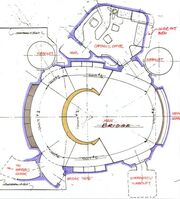
Floor plan

Final bridge design
Andrew Probert made a series of drawings refining the new look for the Enterprise's bridge. An early writers' bible for the new series described the new bridge as combining "the features of ship control, briefing room, information retrieval area, and officers' wardroom. In other words, much the same kinds of things happen here as in the old bridge, but with less emphasis on the mechanics of steering the starship."
That new, less mechanistic approach can be seen in the preliminary designs featuring viewing couches and a conference table on the bridge.
Technical specifications for the Galaxy-class were visible on a display in the conference lounge of the Enterprise-D beginning with the episode TNG: „Chain of Command, Part I”.
- On a side note, a four-foot model of the Enterprise-D was re-labeled as the USS Trinculo (NCC-71867). It was displayed at a restaurant, and never appeared in an episode.
- A Galaxy class camera test model was sold off on the It's A Wrap! sale and auction on eBay. [4]
Technical Manual
The Star Trek: The Next Generation Technical Manual and the Star Trek: The Next Generation USS Enterprise NCC-1701-D Blueprints shows that the Galaxy-class was equipped with a third torpedo launcher that was exposed upon the saucer separating from the battle section.
The Star Trek: Deep Space Nine Technical Manual lists the class' statistics as follows:
- Type: Explorer
- Production Base: ASDB Integration Facility, Utopia Planitia Fleet Yards, Mars
- Accommodation: 1,012 officers and crew; 200 visiting personnel; 15000 personal evacuation limit
- Power Plant: One 1,500+ Cochrane warp core feeding two nacelles; one impulse system in stardrive section, two impulse systems in saucer section
- Dimensions:
- Length: 641 meters
- Beam: 463.73 meters
- Height: 195.26 meters
- Mass: 4,500,000 metric tons
- Performance: Warp 9.6 for 12 hours (STD); warp 9.9 for 12 hours (Uprated)
- Armament: Eleven type-X phaser emitters; two photon torpedo launchers
While the Technical Manuals themselves are not canon, they are Memory Alpha permitted resources.
Apocrypha
- In the Star Trek: Armada series of computer games, the Galaxy-class is referred to as a battleship in gameplay. On screen, the USS Enterprise-D has been casually referred to as a battleship in TNG: „Yesterday's Enterprise” and All Good Things.... However, these instances take place in Alternate timelines and it is not known if "battleship" is an actual starship type within Starfleet.
- In Peter David's "New Frontier" line of novels, Captain Calhoun and crew are given a Galaxy-class replacement for the lost klasa Ambassador USS Excalibur. It is notable for also possessing a designation as the Excalibur-A, something only previously seen with Kirk's USS Enterprise.
- Several Galaxy-class starships have been mentioned in novels and games:
- USS Allegheny (Star Trek: Armada II)
- USS Asgard (A Time to Be Born)
- USS Bolivar (Rogue Saucer)
- USS Breedlove (Star Trek Invasion: Time's Enemy)
- USS Challenger II (The Return)
- USS Cheyenne (NCC-75435) (Star Trek: Borg)
- USS Constitution (Double Helix: Infection; Possession)
- USS Dauntless (NCC-71879) (Star Trek: Bridge Commander) (destroyed in battle)
- USS Excalibur-A (Excalibur: Restoration et al.)
- USS Hood (Station Rage)
- USS Idaho (The Big Game; The Long Night; Star Trek Invasion: The Soldiers Of Fear)
- USS Madison (The Big Game; The Long Night; Star Trek Invasion: The Soldiers Of Fear)
- USS Monitor (Star Trek: Away Team) (assimilated)
- USS Muakaikubo (Star Trek Invasion: Time's Enemy) (destroyed in battle)
- USS Oraidhe (Intellivore)
- USS Oregon (NCC-75698) (Star Trek: Armada)
- USS Potemkin (Station Rage)
- USS San Francisco (NCC-74780) (Star Trek: Bridge Commander)
- USS Trident (Gateways: Cold Wars et al.)
